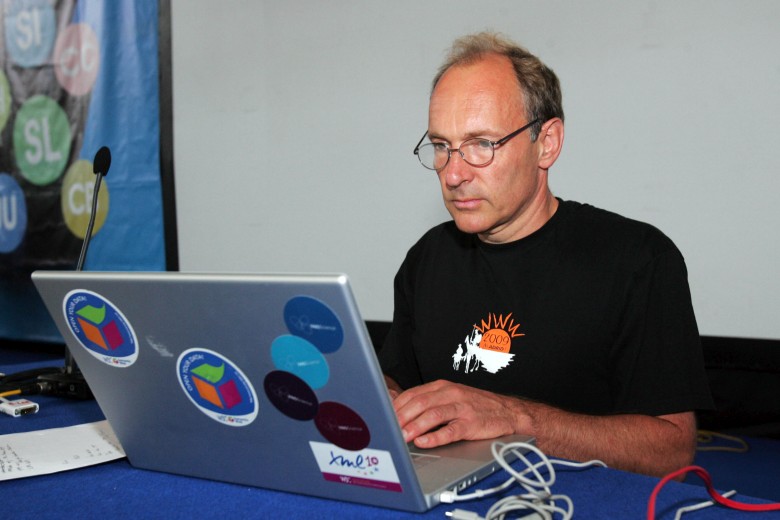Solid technology: it's time to rebuild the web

Sir Tim Berners-Lee at the Campus Party 2008, photo Jonan Basterra
Sir Tim Berners-Lee, creator of the World Wide Web and director of the W3C consortium, is confident that the development of the web has reached a critical point, as much as possible deviated from the original concept. Initially, it was conceived as a decentralized network, where the first browser was also a document editor at the same time. The idea was that each user would not only be able to view documents, but also create, edit them. The web was supposed to be a place of joint creativity and cooperation for all mankind. But something went wrong.
There are examples of successful implementation of joint creativity, like Wikipedia, decentralized hosting sites and peer-to-peer social networks. These are precursors to what the web can become based onSolid technology , which was developed by Tim Berners-Lee, together with a group of researchers from the Massachusetts Institute of Technology. This is the crown of decades of conceptual work, which was engaged in Berners-Lee.
How did the web get to such a loss of decentralization, to a sad current state? The multimedia and editing tools have been removed from the first popular Mosaic browser. It was decided that they are too difficult for the average person. Since this all started. This undesirable transformation of the native offspring eventually led to the suggestion of Tim Berners-Lee and his colleagues to return the missing functionality to the web: in 2003 they proposed a concept called Read-Write Web .
The concept assumes that everyone can participate in the formation of a single web space. For this we need:
- functional permission system (who, where and what can write) based on a common identification system;
- managed data access, since the basis of the web is not only documents but also data.
Now a lot of work on the tools and development tools for this concept has come to an end. Solid technology is a real embodiment of the idea formulated 15 years ago.
Solid technology is based on current W3C standards, which facilitates its implementation and facilitates faster distribution. It implements a system of permissions and identification, the functionality of end-to-end editing of all documents, a data management system and real-time updates via WebSockets.

After registering on one of the solid servers, the user receives an identifier and a personal “container” (solid pod). Alternatively, you can raise the local server. Photo provided by Tim Berners-Lee
Installing a local Solid server
Installation instructions and testing here . The server is installed and works either directly via Node.js, or using Docker.
Supported features:
- Linked Data Platform : A standard for managed data access identified by an HTTP URI. Separately described work with containers, where resources are added by the POST operation
- WebAccessControl : decentralized multi-user access to resources
- WebID-TLS authentication
- The technology allows the user to authenticate to different resources on a single certificate from the browser. The issuance of such certificates for their users can be engaged in any site. The system extends the WebID specification. In the case of a local Solid server, you can generate a self-signed certificate.
- Real-time updates (using WebSockets)
- Verify “Identity” for WebID
- CORS proxy to access data between sites
- Mail server for users
See also:
“Solid opens up incredible opportunities for creativity, problem solving and commerce. This will give individuals, developers and enterprises completely new ways to understand, create and find innovative, reliable and useful applications and services. I see a lot of market opportunities, including robust applications and data warehouses, ”says Tim Berners-Lee in his article of September 29, 2018, where he announced this project and invited everyone to participate.
This week, the Solid repository entered the top of the most popular new repositories on Github, second only to the MS-DOS 1.25 and 2.0 sources , re-populated here from the Computer History Museum.
Perhaps, the Solid technology will be supported by the developers, for this purpose everything is now available. Now in the world the first solid-servers are rising and so far there are quite a few applications that use them . Installing a local server, it is not clear what to do next. Probably, this is how the first users who went on the Internet felt like. But the potential of a new decentralized network may be very large.
“Solid changes the current model, in which users have to transfer personal data to digital giants in exchange for the intended benefits. As we found out, it was not in our interest. Solid is how we develop the Internet in order to restore balance in a revolutionary way, giving each of us full control over the data, whether personal or not, ”- Tim Berners-Lee.Add that along with the announcement of Solid, Sir Tim Berners-Lee launched the startup Inrupt , which will promote the new technology: "Our goal is world domination," the creator of the World Wide Web said modestly in an interview with Fast Company.

